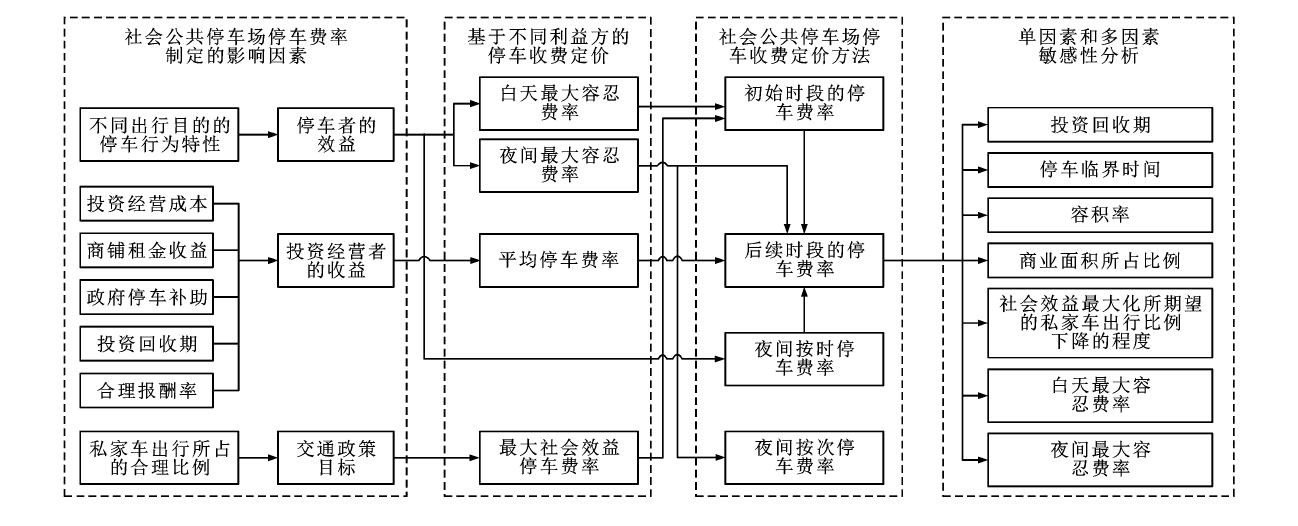Parking pricing method of public parking lots based on multi-aspect comprehensive benefit maximization
-
摘要: 为了保障社会公共停车场后期的顺利投资与经营, 提出了多方综合效益最大化的停车收费定价方法; 考虑了停车者、投资经营者与社会公众的利益与需求, 利用停车特性调查数据分析、成本-收益停车定价模型和点弹性系数模型分别求出停车容忍费率、平均停车费率和最大社会效益停车费率, 分析了停车费用的定价方式, 制定了停车收费方案的合理构成和调整方法, 对比了现有停车定价方法与该停车定价方法对投资与经营效益的不同影响; 研究了后续时段停车费率单因素和3因素敏感性, 建立了后续时段停车费率与3因素之间的关系模型, 分析了3因素不同范围内的组合取值对停车收费方案的影响。分析结果表明: 后续时段停车费率是停车收费方案拟定的关键要素; 投资回收期、商业面积比例和停车场容积率在[-30%, 30%]内变动时, 后续时段停车费率的变化幅度将达到[-50%, 50%]; 控制商业面积比例和停车场容积率变动幅度在[-10%, 10%]内时, 投资回收期不宜取太长; 控制投资回收期和停车场容积率变动幅度在[-10%, 10%]内时, 商业面积比例不宜取太小, 最适宜比例为30%;控制投资回收期和商业面积比例变动幅度在[-10%, 10%]内时, 停车场容积率的取值对后续时段的停车费率影响不大。Abstract: In order to guarantee the successful investment and operation of public parking lots in later stage, aparking pricing method based on multi-aspect comprehensive benefit maximization was proposed.Considering the interests and needs of parkers, investment managers and public society, parking tolerance price rate, average parking price rate and maximum social benefit parking price rate were worked out by using the data analysis of parking characteristics survey, the cost-profit parking pricing model, and the point elasticity coefficient model, respectively.Parking pricing modes were analyzed.Reasonable compositions and adjustment methods ofparking pricing scheme were made.The impacts of investment and operation benefit by the existing pricing method and proposed method were compared.By studying the single-factor and three-factor sensitivities of later period parking price rate, a relationship model between three factors and parking price rate was proposed, and the influences of combination values of three factors within the different scopes on parking pricing scheme were analyzed.Analysis result shows that the parking price rate of later period is the key factor in parking pricing scheme.When the investment recovery period, commercial space proportion and plot ratio of parking lot change in[-30%, 30%], the fluctuation range of later period parking price rate will be [-50%, 50%].When the fluctuation ranges of commercial space proportion and plot ratio of parking lot are both controlled in [-10%, 10%], the investment recovery period should not be taken too long.When the fluctuation ranges of investment recovery period and plot ratio of parking lot are both controlled in[-10%, 10%], the commercial space proportion should not be taken too small, and the most suitable proportion is 30%.When the fluctuation ranges of investment recovery period and commercial space proportion are both controlled in [-10%, 10%], the plot ratio of parking lot has small influence on the parking price rate of later period.
-
表 1 特征变量
Table 1. Characteristic variables

表 2 参数标定结果
Table 2. Calibration result of parameters

表 3 主要指标初始取值
Table 3. Initial value of each main index

表 4 各指标计算结果
Table 4. Calculation result of each index

表 5 停车定价模式评价指标
Table 5. Evaluation indexes of parking pricing modes

表 6 后续时间停车费率的的拟合方程
Table 6. Fitting equations of later period parking price rates

表 7 后续时段停车费率的最小值、最大值和中间临界控制值
Table 7. Minimum values, maximum values and intermediate critical control values of later period parking price rates

-
[1] LIPSEY R G, LANCASTER K. The general theory of second best[J]. Review of Economic Studies, 1956, 24 (1): 11-32. doi: 10.2307/2296233 [2] CHU C P, TSAI M T. A study of an environmental-friendly parking policy[J]. Transportation Research Part D: Transport and Environment, 2011, 16 (1): 87-91. doi: 10.1016/j.trd.2010.07.009 [3] WANG Hua, MENG Qiang, ZHANG Xiao-ning. Optimal parking pricing in many-to-one park-and-ride network with parking space constraints[J]. Transportation Research Record, 2015 (2498): 99-108. [4] ZHENG N, GEROLIMINIS N. Modeling and optimization of multimodal urban networks with limited parking and dynamic pricing[J]. Transportation Research Part B: Methodological, 2016, 83: 36-58. doi: 10.1016/j.trb.2015.10.008 [5] JANSSON J O. Road pricing and parking policy[J]. Research in Transportation Economics, 2010, 29 (1): 346-353. doi: 10.1016/j.retrec.2010.07.044 [6] GREGORY P, DONALD S. Getting the prices right: an evaluation of pricing parking by demand in San Francisco[J]. Journal of the American Planning Association, 2013, 79 (1): 1-37. [7] Seattle Department of Transportation. Annual report 2015onstreet paid parking occupancy[R]. Seattle: Seattle Department of Transportation, 2015. [8] 吴涛, 晏克非, 李枫. 城市公共停车收费定价的研究[J]. 上海铁道大学学报, 1999, 20 (12): 16-20. https://www.cnki.com.cn/Article/CJFDTOTAL-SHTY199912003.htmWU Tao, YAN Ke-fei, LI Feng. A study on urban public parking charging and pricing[J]. Journal of Shanghai Tiedao University, 1999, 20 (12): 16-20. (in Chinese). https://www.cnki.com.cn/Article/CJFDTOTAL-SHTY199912003.htm [9] 李志纯, 黄海军. 弹性需求下的组合出行模型与求解算法[J]. 中国公路学报, 2005, 18 (3): 94-98. doi: 10.3321/j.issn:1001-7372.2005.03.019LI Zhi-chun, HUANG Hai-jun. Model and solution algorithm with combined travel under elastic demand[J]. China Journal of Highway and Transport, 2005, 18 (3): 94-98. (in Chinese). doi: 10.3321/j.issn:1001-7372.2005.03.019 [10] ZHANG Xiao-ning, HUANG Hai-jun, ZHANG H M. Integrated daily commuting patterns and optimal road tolls and parking fees in a linear city[J]. Transportation Research Part B: Methodological, 2008, 42 (1): 38-56. doi: 10.1016/j.trb.2007.06.001 [11] 刘子长, 张小宁, 曹津. 容量限制停车场收费管理[J]. 上海理工大学学报, 2011, 33 (3): 303-306. doi: 10.3969/j.issn.1007-6735.2011.03.014LIU Zi-chang, ZHANG Xiao-ning, CAO Jin. Parking fee management with capacity constrained park lots[J]. Journal of University of Shanghai for Science and Technology, 2011, 33 (3): 303-306. (in Chinese). doi: 10.3969/j.issn.1007-6735.2011.03.014 [12] 田琼, 黄海军, 杨海. 瓶颈处停车换乘Logit随机均衡选择模型[J]. 管理科学学报, 2005, 8 (1): 1-6. doi: 10.3321/j.issn:1007-9807.2005.01.001TIAN Qiong, HUANG Hai-jun, YANG Hai. Mode choice models based on Logit stochastic equilibrium in transportation systems with park-and-ride option[J]. Journal of Management Sciences in China, 2005, 8 (1): 1-6. (in Chinese). doi: 10.3321/j.issn:1007-9807.2005.01.001 [13] 关宏志, 李洋, 秦焕美, 等. 基于TDM概念调节大城市繁华区域出行方式的调查分析——以停车收费价格调节出行方式为例[J]. 北京工业大学学报, 2006, 32 (4): 338-342. doi: 10.3969/j.issn.0254-0037.2006.04.010GUAN Hong-zhi, LI Yang, QIN Huan-mei, et al. Analysis on the TDM-based trip-mode regulation survey in megapolis downtown—a case study on regulating trip-modes by parking pricing[J]. Journal of Beijing University of Technology, 2006, 32 (4): 338-342. (in Chinese). doi: 10.3969/j.issn.0254-0037.2006.04.010 [14] 殷焕焕, 关宏志, 秦焕美, 等. 北京市居住区停车收费价格研究[J]. 城市交通, 2011, 9 (3): 78-81. doi: 10.3969/j.issn.1672-5328.2011.03.012YIN Huan-huan, GUAN Hong-zhi, QIN Huan-mei, et al. Parking pricing of residential communities in Beijing[J]. Urban Transport of China, 2011, 9 (3): 78-81. (in Chinese). doi: 10.3969/j.issn.1672-5328.2011.03.012 [15] 范文博. 用户均衡条件下3类停车设施收费定价模型[J]. 重庆交通大学学报: 自然科学版, 2013, 32 (4): 656-658, 667. doi: 10.3969/j.issn.1674-0696.2013.04.26FAN Wen-bo. Pricing model of three-class parking facilities under user equilibrium conditions[J]. Journal of Chongqing Jiaotong University: Natural Science, 2013, 32 (4): 656-658, 667. (in Chinese). doi: 10.3969/j.issn.1674-0696.2013.04.26 [16] QIAN Zhen, XIAO Feng, ZHANG H M. The economics of parking provision for the morning commute[J]. Transportation Research Part A: Policy and Practice, 2011, 45 (9): 861-879. doi: 10.1016/j.tra.2011.04.017 [17] QIAN Zhen, XIAO Feng, ZHANG H M. Managing morning commute traffic with parking[J]. Transportation Research part B: Methodological, 2012, 46 (7): 894-916. doi: 10.1016/j.trb.2012.01.011 [18] 刘旭东. 三类车位定价权及定价方式[J]. 中国物业管理, 2015 (2): 22-23. doi: 10.3969/j.issn.1671-0991.2015.02.011LIU Xu-dong. Pricing power and methods of parking space[J]. China Property Management, 2015 (2): 22-23. (in Chinese). doi: 10.3969/j.issn.1671-0991.2015.02.011 [19] 李雪梅, 许红. 时空价值理论下的停车场定价机制——以北京为例[J]. 北京交通大学学报: 社会科学版, 2015, 14 (2): 23-30. doi: 10.3969/j.issn.1672-8106.2015.02.004LI Xue-mei, XU Hong. Parking pricing mechanism and the theory of space-time value: with special reference to Beijing[J]. Journal of Beijing Jiaotong University: Social Sciences Edition, 2015, 14 (2): 23-30. (in Chinese). doi: 10.3969/j.issn.1672-8106.2015.02.004 [20] 朱成娟, 贾斌, 韩凌辉. 基于Stackelberg博弈的停车位分配与定价[J]. 交通运输系统工程与信息, 2015, 15 (3): 19-24. https://www.cnki.com.cn/Article/CJFDTOTAL-YSXT201503004.htmZHU Cheng-juan, JIA Bin, HAN Ling-hui. Parking space allocation and pricing based on Stackelberg game[J]. Journal of Transportation Systems Engineering and Information Technology, 2015, 15 (3): 19-24. (in Chinese). https://www.cnki.com.cn/Article/CJFDTOTAL-YSXT201503004.htm [21] 张戎, 诸立超, 林佳妮. 城市中心区路内停车累进计费定价模型[J]. 同济大学学报: 自然科学版, 2015, 43 (1): 90-95. https://www.cnki.com.cn/Article/CJFDTOTAL-TJDZ201501014.htmZHANG Rong, ZHU Li-chao, LIN Jia-ni. Curb parking progressive charging pricing model of city center[J]. Journal of Tongji University: Natural Science, 2015, 43 (1): 90-95. (in Chinese). https://www.cnki.com.cn/Article/CJFDTOTAL-TJDZ201501014.htm [22] KELLY J A, CLINCH J P. Influence of varied parking tariffs on parking occupancy levels by trip purpose[J]. Transport Policy, 2006, 13 (6): 487-495. doi: 10.1016/j.tranpol.2006.05.006 [23] 孙梦琦. 威海市市区机动车停车规划及停车收费标准研究[D]. 哈尔滨: 哈尔滨工业大学, 2005.SUN Meng-qi. Study on parking planning and charging standards of motor vehicles in urban areas of Weihai[D]. Harbin: Harbin Institute of Technology, 2005. (in Chinese). [24] 安实, 马天超, 尹缙瑞. 我国城市停车收费定价模型研究[J]. 哈尔滨工业大学学报, 2000, 32 (2): 65-69. https://www.cnki.com.cn/Article/CJFDTOTAL-HEBX200002017.htmAN Shi, MA Tian-chao, YIN Jin-rui. Parking fee pricing model for urban cities in China[J]. Journal of Harbin Institute of Technology, 2000, 32 (2): 65-69. (in Chinese). https://www.cnki.com.cn/Article/CJFDTOTAL-HEBX200002017.htm [25] 谢志明, 陈先龙. 城市停车场建设投资的综合成本比较分析[J]. 华中科技大学学报: 城市科学版, 2005, 22 (1): 102-107. https://www.cnki.com.cn/Article/CJFDTOTAL-WHCJ200501026.htmXIE Zhi-ming, CHEN Xian-long. Compositive cost analysis on investment of the urban parking lots[J]. Journal of Huazhong University of Science and Technology: Urban Science Edition, 2005, 22 (1): 102-107. (in Chinese). https://www.cnki.com.cn/Article/CJFDTOTAL-WHCJ200501026.htm [26] 缪立新, 杨宽. 城市经营性停车场投资机会分析[J]. 城市规划, 2001, 25 (10): 65-67. https://www.cnki.com.cn/Article/CJFDTOTAL-CSGH200110012.htmMIAO Li-xin, YANG Kuan. The analysis of the investment opportunity on the construction of commercial parking lots[J]. City Planning Review, 2001, 25 (10): 65-67. (in Chinese). https://www.cnki.com.cn/Article/CJFDTOTAL-CSGH200110012.htm [27] 刘松尧, 吕建新. 基于成本-效益分析的公共停车场建设评估模型[J]. 城市交通, 2007, 5 (3): 58-61. https://www.cnki.com.cn/Article/CJFDTOTAL-CSJT200703013.htmLIU Song-yao, LU Jian-xin. A cost-benefit evaluation model for construction of public parking facilities[J]. Urban Transport of China, 2007, 5 (3): 58-61. (in Chinese). https://www.cnki.com.cn/Article/CJFDTOTAL-CSJT200703013.htm [28] 赵路敏. 停车收费对出行方式选择的影响研究[D]. 北京: 北京交通大学, 2007.ZHAO Lu-min. Study on the impact of parking charge on travel mode choice[D]. Beijing: Beijing Jiaotong University, 2007. (in Chinese). [29] TSAI J F, CHU C P. Economic analysis of collecting parking fees by aprivate firm[J]. Transportation Research Part A: Policy and Practice, 2006, 40 (8): 690-697. -





 下载:
下载:










